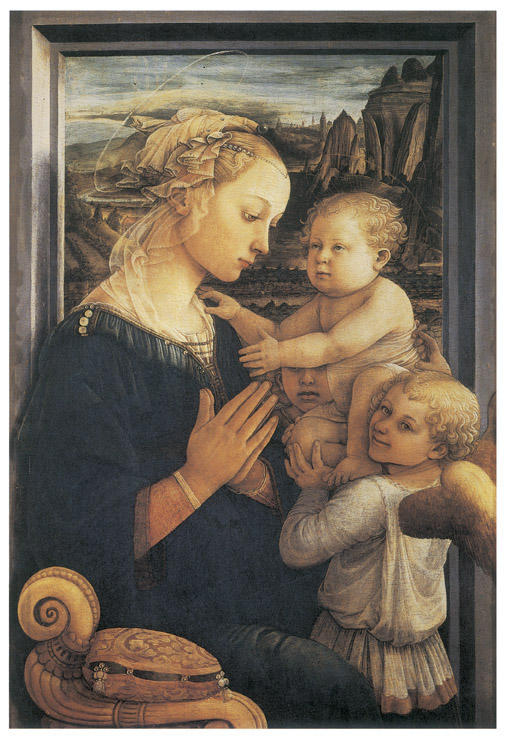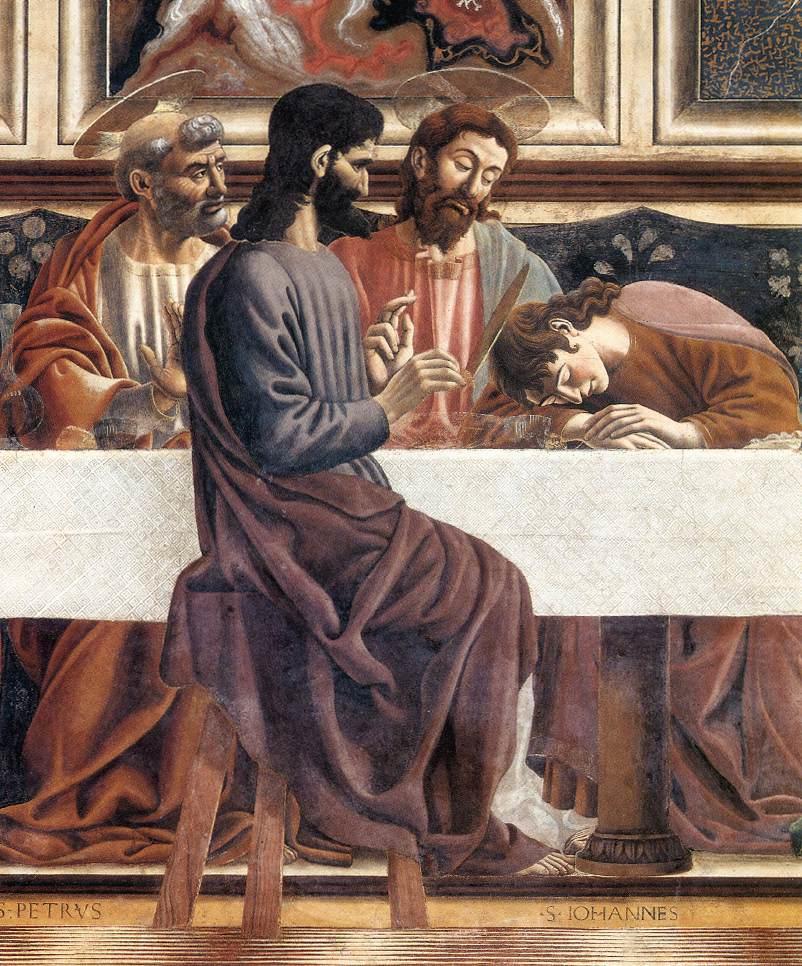Introduction
Artists of the Renaissance clearly made a difference in graphic art. After the discovery of perspective, new tools for expressing certain ideas emerged.
Although the art pieces created by Masaccio, del Castagno and Lippi may seem completely different, with the common thread of Christianity as the only thing that links them, a close analysis of the messages behind their works, as well as the stylistic means, which the artists have chosen to represent these ideas, will show that such pictures as The Virgin and the Child, Madonna and the Child and The Last Supper share a range of similarities.
Masaccio’s The Virgin And The Child
The first to be discussed, Masaccio’s The Virgin and the Child must be one of the most famous and the most talked-about early Renaissance pictures. Apart from being innovative in many ways, including the style, the use of space, and the overall geometry of the picture, the portrait conveys the messages that made the basis for the Christianity in a unique way.

Masaccio clearly aims at using the perspective as the key method of expression and the means of structuring both the picture and the messages behind it. As Adams has noted, “Masaccio follows Brunelleschi’s system in which viewers are assumed to look upward” (Adams 92), and this shows in The Virgin and the Child – the Virgin Mary looks downwards, as if trying to reach out for the crowd beneath; the entire picture looks very massive and does not create the impression that there is a connection between the picture and the viewer.
The use of parallel verticals should also be noted as a very efficient way of rendering the concept of orderliness, which provides the basis for the Christian religion.
Lippi’s Madonna And The Child
At first, the similarity between Masaccio’s Madonna and the representation of the Virgin Mary by Lippi is embarrassingly obvious. Seeing how Masaccio’s works have had a direct effect on Lippi’s art, the link between the artists’ visions of Madonna is quite expected, though. One should note, though, that the choice of the stylistic means of expression, which Lippi picked for his portrayal of Madonna, has defined the uniqueness of his artistic style, at the same time allowing to keep the original message intact (Christiansen 39).

To start with, the color cast, which Lippi chose for his interpretation of the image of Madonna, is quite different from the one that Masaccio picked for his artwork. Apart from the fact that the soothing combination of several shades of brown and yellow contributes to creating an atmosphere of love and sacredness, it also allows for making the scene very humble.
Such a choice of the tone and the mood for the picture can be seen as an homage to the religious ideas of the religious traditions, with the image of a Christian woman as a frail and nearly sexless being. It is remarkable that, in contrast to Masaccio, who depicted the Holy Virgin draped in long clothing that covers her almost entirely, Lippi decided to make a very bold step and put a stronger emphasis on the features that can be related to maternity rather than defining the Holy Virgin as the stronghold of chastity.
It would be a mistake to assume that Lippi’s Madonna is not chaste – far from it; every single element, from clothing to the facial expression signifies her purity, piety, and virtue. However, Lippi seemed to be eager to render the image of a loving Mother rather than the idea of the Immaculate Conception, which had already been worn out by the time, is the key element in the religious artworks of a range of other artists of the era.
Masaccio, on the contrary, uses rather a broad palette, from different shades of yellow and brown to Persian blue, thus, creating the atmosphere of festivity and making the painting look rather solemn.
Apart from the aforementioned air of solemnity, as well as the fact that Lippi tends to put a stress on the maternity issue rather than on the idea of purity, though both of these issues are given an equal amount of significance in Christianity, Lippi also experiments with such expressive elements as the gestures of the people portrayed in his painting, the facial expressions, etc. In contrast to Masaccio, Lippi does not tend to portray the characters with vacant expressions on their faces.
Instead, he depicts the Virgin Mary with her arms folded as if she is about to pray, thus, hinting at her piety; Jesus, in His turn, is portrayed looking at His Mother; thus, the contact between the Mother and the Son is shown in a very delicate and at the same time evident way. This is different from what other artists were doing at the same time slot and, therefore, very peculiar. It seems that Lippi was trying to help the audience relate to the postulates of the Christian religion instead of imposing the latter on the viewers.
The interesting thing is that these works were created at the same point in history, yet absolutely independently, with neither Lippi nor Masaccio bearing in mind the context or the ideas of each other’s paintings. It seemed that there was something in the air of the Renaissance Era, which dictated its own rules for art.
Del Castagno’s Last Supper
The last, but definitely not the least, this artwork may seem quite out of place among Lippi’s and Masaccio’s works. Indeed, apart from the Christian context, such events as the Last Supper and the Immaculate Conception seem to have quite little in common.
However, taking a closer look at the history of the painting, the methods that del Castagno uses in order to get the key message across, as well as the message itself, one will realize that the same principles of perspective and careful choice of color are used in order to render the same idea of piety and humbleness.

In addition to putting very strong stress on humbleness as the basic principle of the Christian faith, one must note that a range of other qualities is shown as a hose of huge significance in the picture. For example, the facial expressions of the people in the picture can be described as sympathetic and empathic, which means that del Castagno obviously meant to point at the importance of compassion for the Christian faith.
Another emotion that the artist was obviously aiming at showing to the audience, the anticipation of the disaster that is about to break out can be spotted rather easily. Thus, del Castagno reminds the audience of the key idea that the entire Christianity is based on, i.e., the concept of redemption. Therefore, The Last Supper seems to render quite different emotions, yet concerns the same idea of conveying the key principles of the Christian thought to the audience through the characters portrayed in the pictures.
Conclusion
Seeing how the artworks created by Andrea del Castagno, Filippo Lippi and Masaccio were produced in the same era, and under the influence of the same tendencies in art and society, it is reasonable to assume that there are going to be certain similarities between three random art pieces created by the aforementioned people.
However, it is quite peculiar that the three authors came up with similar stylistic choices to reflect seemingly different Christian ideas. Unique and at the same time sharing a range of common details, these pictures will remain the symbol of Renaissance.
Works Cited
Adams, Laure Schneider. Italian Renaissance Art. Boulder, CO: Westview Press. 2001. Print.
Castagno, Andrea del. The Last Supper. 1447. Web.
Christiansen, Keith. “Florence: Filippo Lippi and Fra Carnevale.” From Filippo Lippi to Piero Della Francesca: Fra Carnevale and the Making of a Renaissance Master. Ed. Keith Christiansen. 2005. 39–66. Print.
Kleiner, Fred. “Andrea del Castagno.” Gardner’s Art through the Ages: A Global History. Vol. 2. Stamford, CT: Cengage Learning. 2012. 21–23. Print.
Lippi, Filippo. Madonna and the Child. 1452. Web.
Masaccio. The Virgin and the Child. 1426. Web.